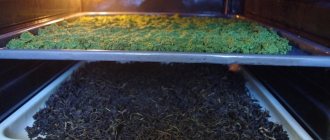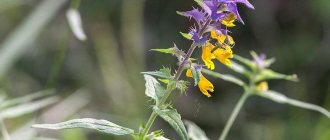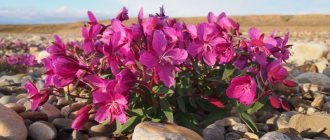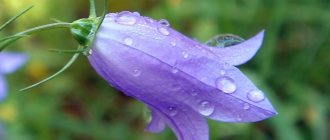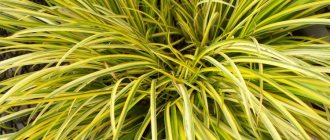The new product quickly became popular: merchants began to mix “pork” into Chinese tea and also sell it separately. The Russian people, of course, were not fools and soon realized that the taste of “koporka” was very different from real tea. However, not everyone could afford a foreign product, so they often agreed to a compromise - less tasty, but more affordable. And if “koporka” had always been sold as a separate product, and not tried to replace the original tea with it, perhaps everything would have turned out differently. But... the temptation was too great to mix fireweed with camellia sinensis and pass it off as a 100% Chinese product. So at some point, the reputation of the “koporka” was expectedly damaged. And, as soon as tea began to be grown in Russia, the fireweed “surrogate” was consigned to the outskirts of history.
In the 21st century, fireweed turned out to be the very new thing that is well forgotten and old. Manufacturers of healthy food products have revived the fashion for it, since it became clear that the composition of this plant (and therefore the drink) is worthy of all attention. This trend was also picked up by the state: it provided financial and ideological support to Ivan tea producers throughout the country.
About the fireweed plant
Blooming Sally
(Koporo tea) is a drink that has a very pleasant taste and color, and has a powerful healing effect!
Even in Rus', an infusion of Ivan tea was used as a drink and medicine for various ailments. This inconspicuous-looking herb is many times superior to even seaweed in its medicinal effects and healing properties, taking into account its unique chemical content.
This is what the leaves and flowers of Ivan tea look like
Fireweed is a perennial plant that produces abundant color. It can reach a height of one and a half meters. The inflorescences look like brushes; they are represented by small flowers of various colors: pink, white, red and purple. The root system is well developed. Ivan-tea blooms from May until the end of summer.
The seeds ripen in August. Together with the fluff, they fly out of the box and spread over several kilometers. If you walk past the thickets of Ivan-tea at this time, you might think that many feather beds have been ripped apart over the field.
One plant can produce up to 20,000 seeds. They are extremely volatile. A seed placed in the soil can remain there for several years, waiting for suitable conditions for germination.
Europe very quickly appreciated the merits of this tea for its unique content. It contains 3.5 times more vitamin C than lemon. In 100 g of leaves its content reaches 200-400 mg. Ivan tea is rich in B vitamins, which remain in it even after brewing.
In addition, there are tannins - up to 20 percent, a large amount of flavonoids, mucus and pectins. Therefore, it is also a powerful antiseptic and anti-inflammatory agent. According to these characteristics, it is superior to many medicinal herbs. Therefore, this product was exported from Russia (before the 1917 revolution) to Europe in huge quantities.
What is Koporye tea?
It is made from plant materials - fireweed leaves. This occurs by analogy with the production of black tea from green tea. The preparation of delicious and healthy tea begins with fermentation - 24-48 hours. The smell, color and taste of the product that will be obtained as a result of all manipulations depends on the time of fermentation and the current temperature. The color of the tea becomes different - green, yellow or completely dark. The black mixture has no competitors on the tea market! Fermentation will be discussed in more detail below.
How to collect?
The plant should be collected away from roads, in environmentally friendly places. It is better to take with you a bag made of natural fabric or a regular pillowcase and place carefully picked leaves and flowers there. Moreover, it is better to take the top leaves, they are juicier and softer, and choose plants that have settled in the lowlands, where there is a lot of moisture. Do not pull the stem out of the ground: this harms the plant population. This means that such a drink will not be good for you either. After all, in nature everything is interconnected.
You don’t have to pull out the plants by the roots, you just need to remove the top leaves from the stem
History of Russian tea. Why did Ivan tea get such a name?
Ivan tea is a plant with a long history. The first information about him is found in ancient Russian manuscripts. It turns out that people drank it even during the construction of Moscow.
The plant is mentioned in the description of the events of 1241, when Prince Alexander Nevsky fought with the German crusaders in the city of Koporye, near Veliky Novgorod. Its residents not only brewed and drank Ivan tea, but also prepared a powder based on it, which they sprinkled on their wounds. The drink itself was already considered healing in those days, so it was offered to soldiers after battles.
Subsequently, it was Koporye that became the main supplier of Ivan tea for the entire country. This happened in the 13th century. Therefore, you should not be surprised by the second name of the drink – “Koporie tea”.
Why did “Russian tea” lose its popularity?
In the 19th century, licenses to supply Ivan tea to England were issued by Alexander I himself. Although Great Britain at that time had its own East India Company engaged in the sale and production of Asian tea, the British preferred the Russian “Koporo” drink. There was an opinion that it was he who gave a person strength and protected from various diseases. Therefore, England bought tons of it from Russia.
Ivan tea was loved not only by residents of Great Britain; it was drunk all over the world. And every year the drink gained more and more popularity. This continued until Koporye tea began to seriously compete with the East India Company. When its owners realized that the market was occupied by Russian tea, active measures began to be taken.
Accusations have been made that the quality of Ivan tea is extremely low. The news was artificially inflated that white clay, which is harmful to health, is mixed into dry raw materials. Although the real reason for such “news” came down to ordinary market competition. As a result, the East India Company achieved its goal: sales of Ivan tea in England fell.
In the 20th century, it was the East India Company that became the organizer of World War I. Its leaders sponsored the revolution and civil war in Russia. Lenin was personally given a large sum of money, for which the leader of the world proletariat stopped the production of Ivan tea in Russia. Today it is no longer a secret that many of the punitive measures of the Bolsheviks were aimed not at the “good” of the people, but at the destruction of the tea industry in the country. Behind all their actions were foreign companies fearing serious competition.
With all their maneuvers, the British tycoons pursued a single goal - to reshape the global sales market, liquidate companies, deprive them of their competitive ability and increase their own turnover.
The purchase of tea in Russia stopped completely in 1917, when England entered the Atlanta military bloc, and the revolution ended in our country. Moreover, during that turbulent time, Ivan tea was no longer only exported, but also sold to its own citizens. Its production was completely stopped, and Koporye was ruined.
Therefore, it is not surprising that now few people know that until 1916, every resident of Russia drank not ordinary black tea every day, but Ivan tea. However, the glory of this healing drink was completely erased and given over to oblivion during the troubled revolutionary times.
Continuation of the story, and the appearance of “tea dust”
When the real threat of the Second World War arose before the USSR, the country's leadership began to realize that the study and practical application of the beneficial properties of Ivan tea was a real opportunity to improve the health of the country's population. Therefore, in those years it was decided to open a research base in Koporye.
By decree of Beria, Ivan tea began to be produced in the town again, from where it was supplied to pharmacies and medical institutions in the country. German intelligence reported this to its leadership as soon as possible. It was found that it is on the basis of this plant that medicinal products are prepared in Russia to improve the health of soldiers. As soon as the opportunity arose, German troops launched a powerful attack on the laboratory in Koporye. This happened in the summer of 1941, and a little later, breaking through to Leningrad, the Nazis took the Koporye Fortress. Having occupied this reliable shelter, Nazi troops began to await the order to continue the defense of Leningrad. However, the commander of the “North” group, Field Marshal General Fon Lei, gave an instruction that surprised them - to go to Koporye and destroy the facility, which at that time functioned under the name “river of life.”
What exactly was hidden under this phrase was discovered only recently. It turned out that we were talking about a biochemical laboratory that was creating a drink based on Ivan tea. It studied ancient recipes, and a remedy had already been practically developed that could increase the endurance of Red Army soldiers.
To get to Koporye, the Nazis made an impressive detour. When the laboratory was found, it was razed to the ground, all documentation was completely burned, and the company’s employees were shot.
This fact is mentioned by historian Alexander Seregin. He writes: “During the Second World War, enemy troops demolished Koporye with their tanks, trampled the fields of Ivan tea with caterpillars, destroyed all the laboratories, and killed the scientists who were studying this plant.”
To eliminate production in Koporye, German troops even disrupted the Barbarossa plan. A. Seregin writes: “In terms of benefits, Ivan tea surpassed all known forms of food. It contains amazing substances that have an effect similar to alkaloids, but they do not intoxicate, but lift your spirits and clear your mind.”
Studying history, one comes to understand why Ivan tea was erased from the life of Russians, why its second name “Koporie tea” was forgotten. A healthy drink with healing properties has been replaced by Asian tea, which stimulates the mind and increases the risk of heart attack and stroke.
Many Russians don't even know what they're brewing in their cups. The fillers in tea bags are dust, which is also sold in the form of granules. To improve the taste and aroma, flavorings and dyes are added to this dust. Another little-known fact is that infusion of black tea leaves is simply dangerous to health. Even in the most expensive premium tea, purines and phenols are formed, which lead to metabolic disorders, causing glaucoma, gout, and high blood pressure in people.
Collecting with Love
You can find many recipes on the Internet, but today we will share exclusively the personal experience of those who dry fireweed from year to year. And you invariably receive a fragrant, tasty and healthy drink. After all, in any business, not only knowledge is important, but also attitude. So experts advise collecting fireweed, fermenting and drying it with love. And Irina Mityushina does this both literally and figuratively:
— We usually collect herbs with our daughter. Her name is Love. And when one day we made a collection as a gift for friends and attached a comic label “Collected with love” to it, our friends immediately realized that we went to the field with Lyuba. We made these comic labels specifically for some occasion, but they stuck for a long time. And now we place them on every bag of herbs or tea that we want to present to someone we know. Everyone already knows and is waiting for our presentations. I like to combine fireweed with currant leaves; the drink adds a pleasant freshness.
Irina’s family usually gives Ivan tea to friends with funny labels.
And this is another obvious plus. I also often give fireweed to friends for the New Year, March 8 and other holidays. Many people ask for more after some time. And I don't refuse. After all, I prepare a lot so that there is enough for everyone. Experience also suggests that tea, collected in a good mood and with good thoughts, gives a positive attitude, inspires and gives a lot of vital energy. So the first rule of preparations is to assemble them easily and with a smile!
In summer, Irina’s herbal preparations occupy the entire balcony. Photo by Irina Mityushina
Useful properties of fireweed tea
The taste of Ivan tea is distinguished by pleasant and aromatic characteristics, it tones the body, encourages and adds vitality. It has a healing effect on the entire body as a whole. In the heat, there is no better way to quench your thirst, regardless of the temperature of the drink. The main thing that makes this drink the most popular, especially for people leading a healthy lifestyle, is that its composition differs from various caffeine-containing drinks and black tea.
It, unlike regular black tea, does not contain such negative elements as oxalic acid, purine bases and caffeine.
Chemical composition
The composition is represented by fresh leaves of fireweed.
Calories 103 Kcal
- Fat:
2.8 g - Proteins:
4.7 g - Carbohydrates:
8.6 g - Water:
71 g - Ash:
2.3 g - Fiber:
10.6 g
| Vitamins | Quantity | % RDN |
| Vitamin C (ascorbic acid) | 56-225 mg | 250% |
| Vitamin B6 (pyridoxine) | 0.63 mg | 32% |
| Vitamin B9 (folic acid) | 112 mcg | 28% |
| Vitamin B5 (pantothenic acid) | 1.36 mg | 27% |
| Vitamin B3 (PP, niacin) | 4.67 mg | 23% |
| Vitamin A (retinol) | 180 mcg | 20% |
| Vitamin B2 (riboflavin) | 0.14 mg | 7,6% |
| Minerals (per 100 g): | Quantity | %RDN |
| Manganese | 6704 mcg | 335% |
| Calcium | 429 mg | 43% |
| Magnesium | 156 mg | 39% |
| Copper | 320 mcg | 32% |
| Zinc | 2.66 mg | 22% |
| Potassium | 494 mg | 20% |
| Phosphorus | 108 mg | 14% |
Other important compounds per 100g:
- Tanning compounds
- 6.12-10.1 mg
- Anthocyanins
- 1.01-1.81 mg
- Lignin
— 8.67-13.8 mg
- Chlorophyll a
— 5.11-8.02 mg/l
- Chlorophyll b
— 9.34-13.56 mg/l
- Flavonoids.
Especially high in quercetin and kaempferol.
- Phytosterols
- Coumarins
- Organic acids
What else is Ivan tea useful for?
- Helps to normalize digestion and metabolism, improves all types of metabolic processes, especially lipid and carbohydrate;
- It has powerful antiphlogistic and antiseptic properties, and is effective as a healing and prophylactic drug in the overall treatment of infections and inflammations. In this regard, the leaves and flowers of this herb are significantly superior to such familiar powerful natural antiseptics as willow bark, oak bark and bear ears. This specific effect of the plant is associated with the content of flavonoids, tannins, carotenoids, vitamin C, organic acids, triterpenoids, and trace elements;
- Prolongs the active life of the male body, maintaining and improving the function of the “second heart” - the prostate gland. In addition, the state of men's health in general significantly improves: it increases potency and normalizes erectile function. It’s not for nothing that Ivan tea is called a “male” herb;
- Has a mild diuretic effect, normalizes water and electrolyte balance, while reducing blood pressure;
- Thanks to the magnesium, B vitamins, and flavonoids contained in fireweed, it is an effective non-synthetic sleeping pill and sedative, normalizes the psycho-emotional state (reduces nervousness, excitability, relieves headaches, normalizes night rest);
- Since Ivan tea contains tannins, mucus, pectins, etc., it is able to improve and restore the functioning of the digestive system, eliminating constipation, heartburn, and dysbiosis. This is achieved through enveloping, anti-inflammatory and reparative effects;
- Due to the presence of organic acids in Koporye tea, together with magnesium and flavonoids, a choleretic effect is manifested;
- Acts on viruses and resists allergies;
- The reparative (that is, wound-healing) effect is achieved due to the presence in the herb content of elements such as chlorophyll, tanning mixtures, carotenoids, which accelerate granulation and epithelization of skin lesions;
- The gradual analgesic effect of Ivan tea occurs due to the alkaloids, mucus, flavonoids, and magnesium present in the flowers and leaves;
- Has lactation qualities, prolonging breastfeeding and thereby improving the health of babies;
- Flavonoids and pectins from Ivan tea leaves are natural adsorbents and cleanse the body of toxic elements;
- Endocrine organs work harmoniously and more efficiently;
- The herb has especially gained success as an antitumor agent due to the antioxidant effect of hangrol and other antioxidants - carotenoids, flavonoids, tannins, copper, organic acids, manganese, vitamin C, magnesium. During scientific research, it was found that angustifolia fireweed contains low-toxic and high-molecular substances that show “interest” in relation to cancer cells;
- Slows down early skin aging, making it elastic and firm. All this is thanks to substances that stimulate the natural processes of collagen synthesis (phytosterols, vitamin C, flavonoids, carotenoids, organic acids and copper).
Ivan-tea for men
Of course, the healing properties of the plant help everyone - men, women, children, but, having the ability to cure prostatitis and prostate adenoma, fireweed has earned the unconditional trust of men.
Ivan-tea for women
This is an unsurpassed remedy for the treatment of cystitis, thrush and other diseases of the genitourinary system in women.
On this topic:
Best Herbs for Women's Health
Collection and storage of fireweed tea at home
How to collect
Ivan tea is collected during its flowering period, that is, from July to August. As soon as the plant begins to fluff, it loses its medicinal properties. How to prepare fireweed tea? It must be collected, fermented and dried. Proper preparation of fireweed can not only preserve, but also enhance the healing properties of the plant.
It is better to collect raw materials in dry weather, after 10 am, when the dew has dried. In hot weather, collection is carried out in the evening. Hold the plant by the peduncle with one hand, and with the other, grab the stem and move from top to middle, collecting the leaves. The lower leaves are left on the stem, because they are coarse and tough, and do not tear off even 3-4 tiers of leaves under the flowers: the plant will still need them. Do not take raw materials from dusty, dirty or diseased plants and try not to damage the stems when collecting. Be careful not to catch a bug along with the leaves, since one foul-smelling insect can spoil several kilograms of raw materials.
You can also collect fireweed flowers separately and then add them to tea.
How to dry at home
In order for the fermentation process of raw materials to begin, it must be dried. The leaves are inspected, separating damaged and diseased ones, then they are laid out in a dark room in a layer 3-5 cm thick on a damp linen or cotton towel. During the process, which lasts at least 12 hours at a temperature of 20-24 ºC, the leaves need to be stirred so that they wilt evenly. How can I make sure the process is complete? Bend a leaf of fireweed in half, and if its midrib crunches, it means the raw material is not ready yet. Leaves that have dried to the required degree do not straighten when compressed into a ball.
- Growing lupine seedlings: sowing and picking
Fermentation conditions
Now let's take a closer look at the processes that transform fresh fireweed leaves into aromatic and healing tea. When the raw material has dried sufficiently, it is necessary to destroy the structure of the leaves so that they begin to secrete juice, which contains substances that promote fermentation. If there is less juice than needed, the fermentation of fireweed will be of poor quality, and this will negatively affect the aroma and taste of the tea.
The leaves must be thoroughly kneaded with your hands, rolling them between your palms, tightly filled with three-liter jars with this mass, covered with a damp cloth and kept for at least 36 hours in the dark at room temperature. Then the mass is removed from the jars, loosened and dried in the oven with the door open, stirring regularly, at a temperature of 95-110 ºC.
Store prepared fireweed tea under a lid in a glass or plastic container in a dark place for at least three years.
If you have a lot of herbs and little time, you can not grind the leaves with your hands, but pass fireweed through a meat grinder , however, in this case, both the healing qualities and the taste of the tea will be weaker. The ground herb is covered with a damp cloth and kept at room temperature for 6-8 hours, and when it acquires the properties of soft rubber to the touch, it is placed in the oven, spread on a baking sheet in a thin layer, and dried at a temperature of 100 ºC, without closing the door and remembering to stir raw materials. At the very end of the process, the temperature can be increased slightly to calcinate the tea mass, as is done with coffee beans. This will only improve the taste and color of the tea. To prevent the raw materials from burning, line the bottom of the oven with ceramic tiles. You will need no more than two hours for the entire drying procedure.
Medicinal properties of Ivan tea
With constant use, Koporye tea is used in the general and preventive treatment of the following diseases:
- Anemia (anemia);
- Gastritis, ulcerative formations in the duodenal bulb and stomach, enterocolitis, colitis, disorders of the biliary system, pancreatitis;
- Inflammatory diseases of the urinary system in men (prostate adenoma or prostatitis);
- Infertility, regardless of gender;
- Too high blood pressure of various origins;
- Urolithiasis, including foci of inflammation in the bladder and kidneys;
- Changes in the respiratory system and ENT organs: tracheitis, pharyngitis, bronchitis, sinusitis, pulmonary tuberculosis. Thus, the positive effect of using infusions and decoctions is due to such qualities of fireweed as expectorant, anti-inflammatory, and fever-reducing;
- Pathology of the spleen;
- Dermatology;
- Herpes;
- Metabolic and inflammatory skin diseases.
Drinking Koporye tea is also recommended for:
- Poisoning and intestinal dysfunction;
- Disturbances in the nervous system - neuroses, alcoholic psychoses, hysteria, depression;
- Epilepsy;
- A general course of rehabilitation from alcoholism to relieve hangover syndrome;
- Increased psycho-emotional pressure and chronic stress;
- The effect of constant fatigue, overwork;
- In dentistry - in children during the appearance of milk teeth, in older age with looseness and inflammation of the gums;
- Endocrine disorders in women of various origins (problems with the menstrual cycle, existing uterine bleeding, menopause, premenstrual syndrome);
- As an adjuvant after manipulations to combat tumors and cancer (chemotherapy and radiation exposure) during the recovery period;
- In the treatment of blood diseases (leukemia or lymphogranulomatosis) as an adsorbent;
- With decreased immunity (immunodeficiency state);
- For vitamin deficiencies, especially vitamin C and group B.
[Video] Dr. Evdokimenko - amazing TEA for GASTRITIS, ulcers, colitis and for NERVES: to relieve tension and anxiety:
How to brew Ivan tea correctly?
No matter how good Koporye tea is, the taste, smell, and color of the drink are largely determined by the quality of the water. Anyone who has ever drank tea with spring or melt water will never forget this taste.
Ideally, one person should consume 5-8 grams of Ivan tea per day - this is 2 tablespoons of dried tea leaves. It makes four to five cups of concentrated drink. The tea can be brewed several times, but please note that the concentration of beneficial properties and taste will decrease.
Proper brewing of fireweed leaves is one of the two main components that ensure the preservation of all medicinal properties.
Recipe for brewing ready-made fireweed tea
2 tablespoons (5 - 8 grams) per 1 liter of boiling water. Its holding time is 10-15 minutes. Lovers of strong tea can increase it to 40 minutes or more.
This tea contains essential oils, so the drink does not spoil within three days, but it is best to drink it freshly prepared. The concentration largely depends on your taste preferences.
You can also drink the tea chilled. If you want to reheat, do not allow it to boil under any circumstances. The subtle aroma will disappear immediately. Drink tea with raisins, dates, dried apricots, honey, halva.
The brewed infusion retains its properties and pleasant aroma for three days, and one portion of the dried plant can be used several times. You can add mint, lemon balm, rose petals, jasmine flowers, rose hips, and honey to tea.
Recipe for a decoction of fresh fireweed leaves
Fresh fireweed leaves are placed in an enamel bowl with a layer of 3–5 cm, then poured with purified water at room temperature (up to 10 cm), after which the infusion is placed on low heat and heated. The next step is to infuse the resulting composition for 10 minutes.
As a brew, you can also take a mixture of leaves and flowers: for half a liter of boiling water, a mixture of flowers and leaves of Ivan tea 2:2 (teaspoons).
Botanical description
A perennial herbaceous plant, fireweed angustifolia reaches from 50 to 200 centimeters in length. The rhizome is formed thick and creeping. Many additional buds are formed on horizontal/vertical roots. They promote rapid and efficient vegetative propagation of the plant.
Content:
- Botanical description
- Brief etymological note
- Chemical composition of raw fireweed leaves
- Useful properties of the plant
- Alternative uses of the plant
- Plant effectiveness studies
The stem is formed erect, round, simple, glabrous and densely leafy. The leaves are alternate, sessile, and the development of a very short petiole is permissible. The leaves are pointed and narrowed towards the base in a wedge-shaped shape, less often rounded. The average length of the leaves reaches from 4 to 12 centimeters, and the width - from 0.7 to 2 centimeters. The edges of the sheets are dotted with glandular-toothed curves, in some cases they develop intact and intact. The shade of the leaves of the plant is dark green with a shiny tint, pale pink or purple-red.
The flowers of fireweed are pale pink or white. Their diameter ranges from 2.5 to 3 centimeters. The petals are collected in a sparse apical raceme, which can reach from 10 to 45 centimeters. The flowering period occurs in the second half of summer and lasts 1 month. Later, pollen grains form in the flowers.
They take the shape of a ball with a diameter of 4 to 8 micromillimeters. The formed fruit is a fluffy, slightly curved capsule, the appearance of which resembles a pod. The seeds are bare, oblong, decorated with fine white hairs on top. Full ripening of the fruit occurs in August-September.
Habitat
The plant prefers the Northern Hemisphere. It takes root best in dry sandy locations, in light forests, clearing areas, and forest edges. Fireweed grows well along railway embankments, ditches, and crops. The plant tolerates moisture well and can grow normally in damp soil.
Ivan tea is the first to populate the soil after cutting down and fires. As soon as other shrubs, trees and plants begin to populate the same soil, fireweed gradually dies out. It is considered a kind of diagnostic species that indicates the condition and fertility of the earth. Most often it grows in combination with raspberry bushes.
Ivan tea spreads across the lands very simply - its long-haired small seeds are carried by the wind to the most remote corners. The seeds “travel” over impressive distances, but remain viable for only a few years.
How much can you drink Ivan tea? Can I drink it every day?
You can drink Ivan tea every day in unlimited quantities. The drink is consumed hot and cold, with various additives. Ivan tea does not stain tooth enamel.
Koporye tea is given to children during teething. It is offered to pregnant and lactating women. It contains no caffeine, it perfectly calms the nervous system and quenches thirst. In the morning, Ivan tea helps to cheer up and gain strength.
Historian Alexander Seregin
suggests that there used to be a large samovar with Ivan tea on the table throughout the day. People ate practically nothing, but drank this invigorating drink. Ivan-tea and a piece of bread - this was enough for the working people.
Withering of the leaf
One of the most important stages, as we understand in practice. The quality of twisting and fermentation depends on how the leaf is dried.
We lay out the leaves in our small house, on large pieces of fabric, in layers of about 7-10 centimeters. The room is cool enough for this process; excess moisture leaves the raw material gradually. This stage lasts about 5 hours, during which we constantly stir the sheet to ensure even wilting.
How do you know when a sheet is ready? You need to try to bend it. If the sheet crunches and breaks, then it is not yet ready for the next stage. After withering, the fireweed leaf should not be brittle or dry.
When to collect and how to properly dry fireweed?
Ivan tea is collected during the flowering period; it is important to collect the grass at a time when the flower cluster has not yet fully blossomed. Flowering begins at the end of June and continues until autumn. In August, beans ripen on the lower branches of fireweed, inside of which there is unpleasant fluff; it should not be included in the harvest.
It is recommended to collect in dry weather; do not start immediately after rain. Dusty, dirty, diseased and damaged plants are not suitable for collection. Ivan tea, growing along busy roads, is not intended for medicinal preparations.
The young tops of plants, collected in May, are so fragile and sensitive that structural changes begin even during compaction in the container.
The above-ground part of the plant is suitable for preparing medicinal infusions and decoctions, so during collection it is cut or broken in the middle, sometimes closer to the ground.
Next comes the process of fermentation of Ivan tea.
When to go to the field?
There is an opinion that the plant should be collected on Ivan Kupala, they say, it is on this day that all herbs gain maximum strength and beneficial properties. However, as we understand, these are conventions.
The optimal time for collecting fireweed is the end of June and the beginning of July. Can be collected with or without flowers. Irina Mityushina practices different options for harvesting plants, collecting them before flowering, during flowering, and even after. And fireweed tea collected at different times will have different shades of taste. You can understand what you like best only through experience. I’ll tell you about myself that I used to collect without color, but since last year I’ve changed my preferences: color gives the collection an attractive appearance, and the drink an excellent subtle aroma.
The color can also be dried and brewed
Application of fireweed tea
Healing infusions and decoctions have anti-inflammatory, antibacterial, astringent, diaphoretic and enveloping effects.
Ivan tea has a pronounced sedative effect on the body (according to the mechanism of action and therapeutic effect, the infusion of this plant is close to the effect of valerian officinalis). It is used for neuroses, increased excitability, aggression, insomnia, frequent awakenings at night, anxiety and sudden mood swings.
The water infusion is used as an anesthetic for headaches, as an enveloping agent for diseases of the gastrointestinal tract (ulcers, colitis, gastritis, dysbacteriosis, etc.).
The anti-inflammatory effect of fireweed is successfully used in the treatment of diseases of the genitourinary system, including chronic and acute cystitis and inflammation of the urinary tract. For men, the use of medicinal infusions will help cope with chronic prostatitis and prostate adenoma.
The antibacterial effect of the medicinal plant is used for diseases of the oral cavity - sore throat, stomatitis and gingivitis.
The chemical composition of fireweed tea includes ascorbic acid, manganese and iron, which make it possible to use the plant infusion as an adjuvant in the treatment of iron deficiency anemia.
Application for:
- During pregnancy
- Ivan tea for children
- In cosmetology
Ivan tea during pregnancy
Ivan tea is a plant for which no contraindications have been identified to date, so pregnant women can take it if necessary.
Tea prepared on the basis of fireweed is a natural remedy for the treatment of hyperacidity gastritis, colitis, and stomach ulcers. The plant has an anti-inflammatory effect, helps overcome headaches, nasopharyngeal diseases, and sore throat.
The vitamins and other beneficial substances that make up fireweed have a positive effect on wound healing and contribute to the normal course of pregnancy, which further confirms the safety of its use for pregnant women.
Ivan tea for children
Ivan tea is recommended for infants at the time of teething. Possessing excellent anti-inflammatory and analgesic effects, it greatly facilitates this difficult process.
The plant has antiviral properties and is used as a prophylactic agent during exacerbation of seasonal diseases (influenza and ARVI).
Application in cosmetology
Recipe No. 1 – infusion.
Fireweed flowers (1 tablespoon) should be poured with 1 glass of boiling water. Used as a steam bath before a cosmetic massage. The procedure is carried out every 10 minutes every day for 1-2 hours a day.
Recipe No. 2 – anti-inflammatory mask.
To prepare the mask, you need to take 10 ml of tincture of fireweed flowers with vodka, a pinch of “Extra” salt and oatmeal. Mix the ingredients (you should have the consistency of liquid sour cream). The mask should be applied to the face for 10 minutes.
Recipes for specific diseases
Infusions of fireweed leaves are recommended for treating and calming the nervous system, treating the reproductive system in women and men, and bleeding. Infusions are also used for headaches and insomnia.
Ivan tea for prostatitis.
To use the infusion for prostatitis and prostate adenoma, use the following recipe: 15 g of crushed medicinal raw materials (aerial and underground parts of the plant) are poured into 200 ml of boiling water and infused for 1 hour, after which the resulting infusion is filtered and taken 15 ml (1 tablespoon ) 3 times a day.
From otitis media, stomatitis and tonsillitis.
For external use of the infusion (for otitis, stomatitis and sore throat): 2 tablespoons of dry medicinal raw materials are poured with 400 ml of boiling water (it is better to use purified water) and infused for 6 hours, after which the resulting infusion is filtered and used as needed.
For diseases of the genitourinary system.
For use in various diseases of the genitourinary system, including chronic cystitis and inflammation of the ureters: 1 tablespoon of dry crushed raw materials (leaves) is poured into 200 ml of boiling water and left for two hours, then filtered into a clean container. Use 1/3 cup (50–60 ml) 3 times a day.
As a sedative.
To use the infusion as an analgesic and sedative (including for insomnia): 1 tablespoon of crushed raw materials (root with rhizome) is poured into 200 ml of boiling water and infused for 45 minutes, after which the resulting infusion is filtered into a clean and dry container. Take 15 ml (1 tablespoon) 3 times a day.
From alcoholism.
To reduce cravings for alcoholic beverages, as well as to restore the psyche after giving up alcohol, you need to drink Ivan tea mixed with dry thyme herb in a ratio of 5:1. When you feel the desire to drink an alcoholic drink, add honey to the tea and take 5-7 servings a day.
To reduce cravings for tobacco.
The psyche of a person who gives up cigarettes becomes more vulnerable to even the slightest irritants. In addition to increased nervousness, insomnia may occur. However, this is not a reason to start smoking again. It is enough to prepare an infusion of fireweed, which helps normalize the psyche.
Recipe:
- Mix 1 dessert spoon of Koporye tea and peppermint.
- Add 0.5 liters of boiling water and soak for 15 minutes in a water bath.
- Cool the drink and take 100 ml 5 times a day.
Ivan tea helps eliminate toxins, normalizes sleep, and calms the nervous system. Improvement can be noticed after 14-20 days of regular use.
How to prepare
The leaves are mainly used to prepare fireweed. Dried, packaged in bags and sold. But those who are seriously involved in herbal medicine prefer to prepare their own fireweed.
Every nuance matters in the preparation: time, place, method of the cathedral, even the weather. Young shoots are sometimes harvested for brewing as early as May. Although July is considered the right time for collection. At this time, it has half blossomed, but there are no fruits with seeds yet. Closer to autumn, the leaves lose moisture and healing qualities.
Seeds containing fluff are not used for medicinal purposes; their inclusion in the drink is undesirable. Therefore, starting from August, when the fruits ripen, it is not advisable to harvest.
For collection, fireweed should be collected from open but shaded areas, for example, from forest edges. Grass that grows near the road is not good - it absorbs toxins from exhaust fumes. For the same reasons, it should not be collected near industrial enterprises.
Dust-covered, damaged, faded, wilted leaves are not suitable. Plant elements must be clean and fresh. However, harvesting immediately after rain is not recommended - rain moisture washes away the useful elements. Therefore, it is better to collect in dry weather. However, heat is also not welcome, as it leads to drying out.
To harvest, some sources recommend cutting the stem with pruning shears in the middle or closer to the ground. But it's better not to do that. If you cut it, you may not find the plant here in a year. It is easily replaced by other herbs.
Choosing those that are located closer to the inflorescences. And the lower ones, firstly, are hard, and secondly, they will further saturate the remaining part with moisture. Flowers are also collected - they are also dried and added to a tea drink.
Recipe for kvass with Ivan-tea
Kvass based on Ivan tea tastes no worse than bread kvass, but in terms of benefits it is many times superior. This drink helps cope with thirst and saturate the body with amino acids and microelements. It can be used as a base for making okroshka.
Recipe:
- 18 g of Koporye tea (about 6 tablespoons) are poured into a glass teapot and filled with 2 liters of clean water.
- Close the kettle with a lid, place on the stove and bring to a boil.
- Boil the drink over low heat for 5 minutes.
- Infuse the decoction for 6 hours.
- Place 3 tablespoons of sugar into a glass jar.
- Add yeast-free starter (about 1/2 tablespoon) to it, pour in the strained decoction of Ivan tea and mix.
- Place the jar in a warm place to ferment for 2-3 days.
- To saturate the drink with carbon dioxide, pour 1 teaspoon of sugar into a 1.5 liter bottle and pour fermented kvass into it through cheesecloth.
- Place the bottle of kvass in the refrigerator for a day. During this time, it will be saturated with carbon dioxide and will be completely ready for use.
Video recipe for “atomic” kvass:
What does fireweed look like?
What does fireweed look like? It is very difficult to confuse such a plant with others. The leaves of fireweed are oblong or wedge-shaped with short petioles, which, after flowering, turn into small boxes in which the seeds ripen. The stem has a straight shape. The height of the flower is approximately 1.5-2 meters (it all depends on where it grows). The buds have a pink or purple-pink hue. Rarely found white.
Contraindications to the use of fireweed tea
If you drink tea for more than one month continuously, gastrointestinal dysfunction is possible.
Use fireweed tea (infusion, decoction) with caution in cases of blood coagulation disorders (thrombophlebitis and varicose veins).
There is an opinion that Ivan tea is not recommended for children under 2 years of age, but this fact has not been confirmed in any way; on the contrary, there are facts about the benefits of its use (in small quantities!)
Caucasian
Caucasian fireweed is an ornamental perennial herbaceous plant, the height of which is 10-50 cm. Its stems are bare, extending from the base, can occasionally be creeping, the leaves have a linear-lanceolate shape, their length is 3-5.5 cm . The petals of Caucasian fireweed flowers are round, and the flowers themselves are quite large (up to 3 cm), collected in short racemes.
Photo.
Western Caucasus, Stavropol Territory, Adygea - this is where you can find this plant. The main places where fireweed grows are river valleys, pebbles, and the alpine belt.
